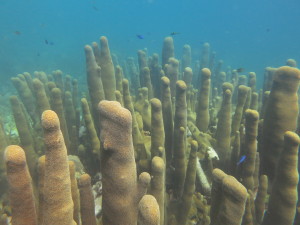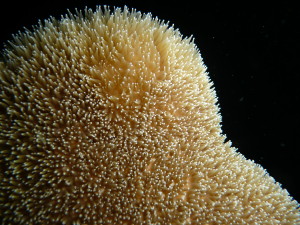
Where do babies come from? You’ve probably figured out the answer to that one. But where do coral babies come from? Yes, that’s right, coral babies.
For some of the most common reef-building coral species, scientists are now quite good at studying their reproduction. But when it comes rare and threatened species, we are often starting at the very beginning: Where do their babies come from? When do these coral species reproduce… and how?
In BMC Ecology this week, my colleagues and I describe how we studied a unique and important Caribbean coral species, and for the first time managed to raise their babies in the lab.
The Pillar Coral Dendrogyra cylindrus, which grows only in the Caribbean, was listed as ‘threatened’ by the U.S. Government at the end of 2014. Pillar corals have an important job on the reef; by building large, tall pillars (they look like the smoke stacks of a refinery), they not only form habitat and safe refuge for fish, but they also help to reduce the energy of storm surge as it approaches shore. Because of their unique shape and rarity, finding a large pillar coral on a scuba dive in the Caribbean is a special moment.

In some parts of the Caribbean, there are large stands of many hundreds of pillar corals. Yet very mysteriously, small juveniles of this species have never been found in over 30 years of scientific surveys in the Caribbean. This left scientists and managers with many questions: Where are the juvenile pillar corals? Can this species still reproduce at all? How can we help rebuild populations of the species if there are no babies being born?
The challenge of breeding an elusive species
Our scientific mentors, colleagues, and peers have spent years improving methods for studying coral reproduction. By applying this knowledge to the Pillar Coral over the past few years, we’ve now been able to successfully raise their juveniles for the first time. This is great news for the species: it gives us evidence that this species is in fact still able to reproduce. We now know that there are males and females living near one another, and that their gametes still ‘work’ when they meet each other.
In some parts of the Caribbean, there are large stands of many hundreds of pillar corals. Yet very mysteriously, small juveniles of this species have never been found in over 30 years of scientific surveys in the Caribbean. This left scientists and managers with many questions.
Still, studying this species presented a number of challenges. The pillar corals spawn only in August and September, and this species spawns differently than most coral species. Most spawning corals are hermaphrodites that release large bundles of eggs and sperm, packaging as many as 50 or 100 eggs together in each bundle. But in the case of the pillar corals, each individual colony is either all-male or all-female.
The females release tiny, individual eggs into the seawater. And the males release sperm straight into the seawater. To make it even more complicated, they don’t do this at the same time; the females wait to release their eggs until after the males have spawned. This makes the research more difficult; collecting these loose eggs and freely-spawned sperm is much harder than collecting big fat combination bundles of both. For this study, it took us two years before we figured out how to collect the material and raise the juveniles. Then it took us another year of observation to complete the study.
First sight of a juvenile
Surprisingly, the dividing embryos went through development very quickly, the swimming larvae went through the attachment and settlement process very quickly, and the settled ‘polyps’ survived very well, even in the laboratory, which is not the most natural of environments. We assumed they would be fragile based on our work with other species, but the little pillar coral settlers kept surprising us with their robustness!
This is more good news; it means this species may be relatively easy to raise in larger numbers in the lab so that scientists can study all of the factors critical for their survival. It seems trivial, but for scientists studying coral reproduction and larval biology, just getting our research materials – coral babies – in the first place takes a huge amount of preparation, care, and work. Only after weeks of preparation, diving, labwork and stress do we even get to start doing our experiments with the juvenile corals!

Because we’ve never seen very tiny juvenile pillar corals in nature, our photos of the settlers that we raised in the lab are the first-ever photos of baby pillar corals. Charmingly, they do look a lot like their parents – they have big, fat tentacles that they extend during the day, and each tentacle has a little ball at the end. With these fat tentacles and the small skeletal cup around their bodies, they look like really tiny court jester hats.
In the course of our research, we also produced the first multi-year dataset on pillar coral spawning times. We found that this species in fact is quite predictable in its spawning behavior, even more so than some of the corals whose reproduction is better studied. That’s more good news because it means it will be fairly easy for scientists to be underwater in the right place and at the right time in future years to study and collect gametes from this species.
Conserving the species
Beyond the benefits to other scientists, can our new research help conserve this threatened species? It might! In addition to having new study tools to share with other Caribbean coral researchers, we can also now outplant a few settlers back to the reef. We don’t know how easy that will be, and it could take years before it works at all, but now we can start to experiment with different strategies.
We can’t yet rebuild a reef with outplanted corals, but we learn a lot about their needs every time we try this on a small scale. We use the analogy of human in vitro fertilization; it is difficult and expensive, and not the first choice strategy to make babies, but we can make a difference for a few very precious babies and learn a lot about what every growing baby needs in the process.

Overall, this research gives us many reasons to be hopeful. It means this threatened and unique coral species can still reproduce and has the potential to be a fairly cooperative study species. Despite the many threats they face in the wild, we can be cautiously optimistic about their future. Anytime you have a threatened species successfully making babies, you have reason to smile.
Because we work on tropical islands, we know how difficult it can be for marine resource managers to get access to the best and most reliable information for conservation and management. For that reason, we very enthusiastically published this research in an open access journal. In fact, we didn’t even pause to consider publishing this in a closed-access format!
We believe it is too important for the future of reefs to hide important coral conservation research behind a paywall. Encouragingly, in the field of coral reefs, we are seeing researchers choose to publish more and more of their vital, conservation-relevant research in open access journals. In coming years, we hope to see this trend, and the baby corals, continue to grow.
Visit Kristen’s photo gallery about how scientists study coral spawning
Comments